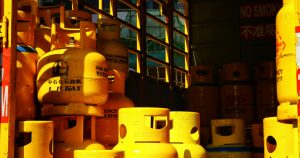When a chemical spill occurs, most organisations focus on the immediate response—containing the spill, cleaning up, and restoring operations to normal. However, the actual cost of chemical spills extends far beyond the clean-up crew and absorbent materials. Understanding these hidden costs reveals why prevention through proper transfer systems isn’t just about safety—it’s a sound business strategy.
The Immediate Visible Costs
The costs you can see and measure immediately include cleanup materials such as absorbent pads, booms, and neutralising agents, which can cost hundreds to thousands of pounds depending on the spill size. Emergency response team time diverts workers from productive activities, while specialised cleaning services for large spills or hazardous materials can run into tens of thousands of pounds.
Damaged equipment and materials exposed to corrosive or reactive chemicals may require replacement or extensive decontamination. Production downtime during cleanup and safety investigations often results in lost revenue that exceeds the direct costs of cleanup. Contaminated product batches may need disposal, particularly in pharmaceutical or food processing, where even trace contamination is unacceptable.
For a typical mid-sized facility, a moderate chemical spill can easily cost £5,000 to £15,000 in immediate expenses. Larger spills involving evacuation, specialised response teams, or environmental contamination can reach hundreds of thousands of pounds.
Regulatory and Legal Consequences
Chemical spills trigger regulatory obligations that create substantial costs. Under the Control of Substances Hazardous to Health (COSHH) Regulations and the Environmental Protection Act, organisations must report inevitable spills to the Environment Agency or local authorities. Investigations follow, consuming management time and potentially resulting in enforcement actions.
Health and Safety Executive (HSE) investigations can lead to improvement or prohibition notices requiring corrective actions at significant expense. Serious incidents may result in prosecution, with fines for health and safety breaches reaching into hundreds of thousands of pounds. In 2024, the average fine for health and safety offences in the UK exceeded £150,000, with some cases resulting in penalties of millions.
Environmental damage creates additional liability. Soil or water contamination requires remediation that can cost hundreds of thousands to millions of pounds, depending on the extent and location. If spills reach watercourses, organisations face prosecution under environmental protection legislation, substantial cleanup costs, and potential civil claims from affected parties.
Insurance implications compound these costs. Claims for chemical spills increase premiums, sometimes dramatically. Repeated incidents may make coverage difficult to obtain or prohibitively expensive.
Employee Impact and Human Costs
Chemical exposure from spills affects employees in ways that create both immediate and long-term costs. Workers exposed to hazardous substances require regular medical evaluations and ongoing monitoring. Depending on the chemical and exposure level, this might include emergency treatment, ongoing medical surveillance, and long-term health monitoring.
Compensation claims from affected employees can be substantial. Even if exposure doesn’t cause immediate injury, anxiety about long-term health effects can lead to stress-related claims. Workers’ compensation costs continue to rise, and serious incidents can lead to personal injury litigation.
The psychological impact on the workforce extends beyond those directly exposed. Witnessing a serious spill creates anxiety about workplace safety, which can reduce morale and potentially lead to increased turnover. Recruiting replacement staff becomes more difficult if the facility develops a reputation for safety incidents.
Lost productivity affects not just those directly involved but the wider team. Workers may be distracted, concerned about safety, or dealing with additional workload while colleagues recover. This productivity drag can persist for weeks or months after an incident.
Operational Disruption
Chemical spills disrupt operations in ways that cascade through the organisation. The affected area may be shut down for hours, days, or even weeks, depending on spill severity. This creates bottlenecks throughout the facility as production schedules are disrupted, orders are delayed, and resources are reallocated.
Equipment contamination may require extensive decontamination before resuming use. In pharmaceutical or food processing, entire production lines might need revalidation after chemical exposure, a process that takes weeks and costs tens of thousands of pounds.
Supply chain impacts ripple outward. Customers waiting for delayed deliveries may impose penalties for late delivery, cancel orders, or shift to alternative suppliers. Long-standing customer relationships can be damaged when a single spill disrupts supply. Just-in-time manufacturing customers are particularly intolerant of delays.
Staff redeployment during cleanup and recovery reduces efficiency across the facility. Workers unfamiliar with substituted tasks work more slowly and make more errors. Overtime costs mount as the organisation tries to catch up on delayed production.
Reputational Damage
The most significant long-term cost is reputational damage. In today’s connected world, incidents rarely stay contained. Employees share experiences on social media and review sites. Customers learn about problems through delayed deliveries or quality issues. Regulatory actions become public record, accessible to anyone researching your organisation.
For businesses serving regulated industries like pharmaceuticals or food processing, a serious chemical spill can raise questions about overall quality management and compliance culture. Customers in these sectors may require additional audits, implement enhanced monitoring, or shift volume to competitors perceived as more reliable.
Environmental incidents generate particularly negative publicity. Organisations positioned as environmentally responsible face severe reputational damage when spills impact local ecosystems. Community relations suffer, making it harder to obtain planning permissions, recruit local staff, or maintain social license to operate.
Investor and stakeholder perception shifts after serious incidents. Environmental, Social, and Governance (ESG) criteria now influence investment decisions, and chemical spills signal poor environmental management. This can affect share prices for public companies and make private companies less attractive to investors.
Lost Opportunity Costs
While dealing with the spill aftermath, organisations miss opportunities. Management attention focuses on incident response and remediation rather than growth, innovation, or improvement initiatives. Sales teams spend time explaining problems to customers rather than developing new business. Operations teams manage recovery rather than optimising processes.
New business opportunities may be lost because prospects perceive the organisation as poorly managed or unreliable. Tender responses must disclose recent incidents, putting bids at a competitive disadvantage. Some opportunities, particularly in regulated industries, may become entirely inaccessible after serious safety or environmental incidents.
The Prevention Dividend
Understanding the true cost of chemical spills reveals the value of prevention. Investing in proper transfer systems that eliminate spill risks delivers returns through:
Avoided incident costs: Even preventing a few minor spills annually can justify the investment in enclosed transfer systems. Preventing one major spill can save many times the system cost.
Reduced insurance premiums: Demonstrating robust spill prevention measures can result in insurance cost reductions of 10-30%, with payback periods of just a few years.
Improved productivity: Workers operate more efficiently without disruptions from spill cleanup. Equipment runs more reliably without contamination incidents.
Enhanced reputation: Organisations known for strong safety and environmental performance attract better customers, employees, and investors. This competitive advantage has quantifiable value, as evidenced by premium pricing, lower turnover, and improved access to capital.
Regulatory confidence: Proactive spill prevention fosters positive relationships with regulators, resulting in reduced inspection frequency and lower enforcement likelihood.
Calculating Your Risk
Organisations should assess their spill risk by examining factors such as transfer frequency, chemical hazards, historical incident rates, and near-miss frequency. Multiply the probability of spills by their potential cost—including all the hidden expenses discussed above—to determine risk exposure.
Most organisations find that even low-probability, high-consequence spills justify significant investment in prevention. A 5% annual probability of a £100,000 spill represents £5,000 in expected annual losses—a figure that doesn’t include any of the hidden costs explored here.
Making the Business Case
Presenting spill prevention investments to decision-makers requires a comprehensive cost analysis. Include not just cleanup costs but regulatory exposure, insurance impacts, productivity losses, reputational damage, and opportunity costs. Compare this total risk exposure to the cost of enclosed transfer systems.
For most chemical handling operations, proper transfer systems deliver a return on investment within 2-3 years, primarily through the avoidance of spills alone. Including broader benefits like improved productivity, reduced insurance costs, and enhanced reputation makes the business case overwhelming.
Taking Action
Chemical spills are expensive in ways that extend far beyond the immediate cleanup. Organisations that understand these costs recognise that spill prevention isn’t an expense—it’s an investment with demonstrable returns.
Evaluating your chemical transfer operations and implementing appropriate enclosed systems protects your business from the true cost of spills, while also improving efficiency, safety, and your competitive position.


